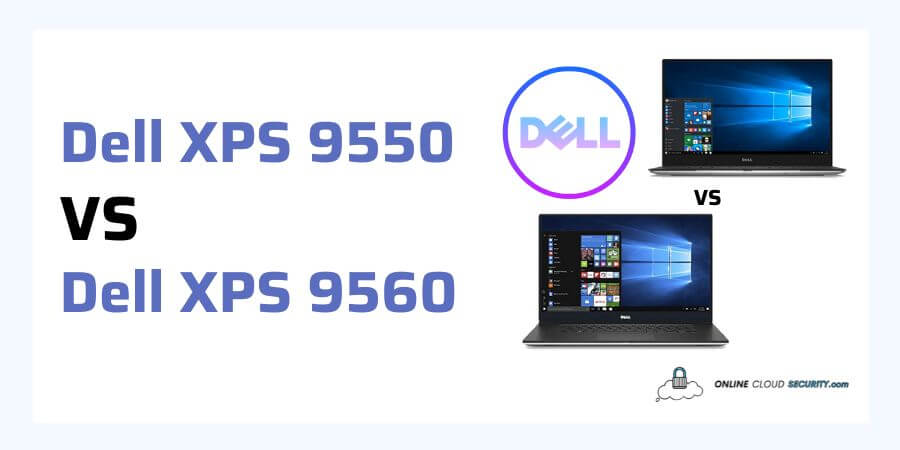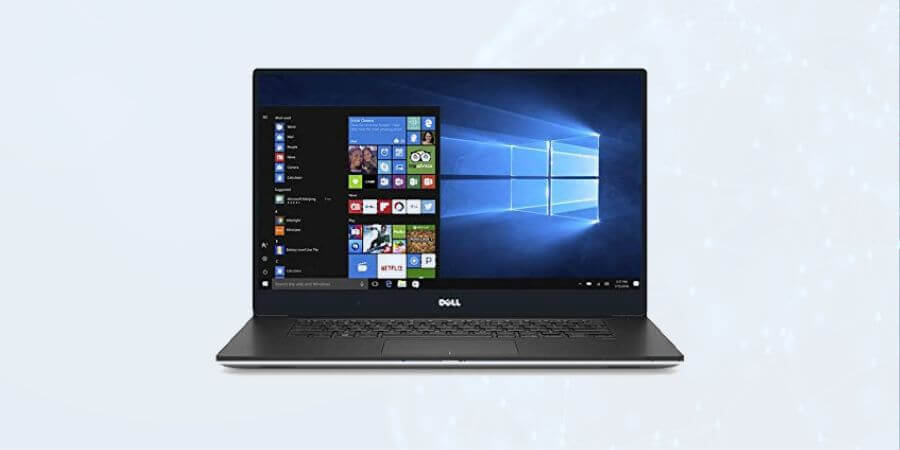
Dave Miller – Tech Enthusiast & Security Expert – July 28th, 2022

Since Dell makes high-end laptops under the XPS series, I’ll compare the Dell XPS 9550 vs Dell XPS 9560 to determine which is better for you in today’s computer world. Overall, many Dell laptops provide a combination of technology and features that can process data and handle heavy workloads when it comes to getting the job done. You will meet the performance demands no matter which laptop you choose from the Dell XPS series. But today, we’ll talk about these two laptops, which have unique features that set them apart from the other models in this lineup but also have some critical differences.
Continue reading the article, and I’ll go through the noticeable distinctions between the two to make it easier for you to make a choice.
Dell is a global technology corporation based in the United States that creates computer-related goods and services. While Dell XPS is a range of consumer-focused high-performance series produced by Dell, also referred to as eXtreme Performance System. The XPS signature first appeared in 1990, when Dell prioritized commerce with corporations over consumer demand. In 2001, the XPS line effectively concentrated on being a line for fast computers as a successful series.
Statistics: Dell delivered 27.1% of all PC units in the US during the first quarter of 2022, demonstrating its supremacy as it sold 17.7% of all PC units worldwide. Customers may choose from various high-end devices Dell’s well-known PC line offers.
The XPS line has undergone a lot of changes. It has consistently emphasized the need to keep up with the rapidly changing technological environment and user computing requirements. Despite this, later, it lost its status as the cutting-edge performance machine, prompting Dell to redesign the XPS line in 2005. It was all done to compete with Alienware, which was independent of Dell at the time.
When the M17x was released as the first Alienware/Dell branded machine, the XPS line’s specs began to deviate from those provided by the Alienware division. The two models I’ll be comparing today are the Dell XPS 9550 vs Dell XPS 9560, with the former coming out in 2015 and the latter being a slightly improved variant that came out in 2017.

In 2015, Dell updated their XPS 15 series, switching from the Alder Lake-U Intel Core CPUs seen in the XPS 13 to Intel’s Skylake processors. It resulted in the development of the XPS 15 9550, one of the most remarkable high-end desktop replacement laptops for professionals and enthusiasts. The XPS 15 9550 got marketed as the all-in-one Dell’s most powerful XPS laptop for users to fly through the most demanding tasks. The best part was that it maintained the best design elements from the modern XPS 13 lineup while adding its new unmatched screen, accelerated hardware, and a badass design.
Not to be overlooked is the fact that despite several hardware, software, and firmware problems, the XPS 9550 kept the top spot among its competitors for its entire lifecycle.

Soon after the XPS 15 9550 was released, Dell unveiled the equally impressive XPS 15 9560. It kept the same appearance as the XPS 15 9550 from the previous year. Still, it received an upgrade to Intel Kaby Lake CPUs and a GPU upgrade with the most cutting-edge PascalTM architecture. It lets you breeze through your most demanding activities. Performance significantly improved due to this upgradation, and the Dell XPS 15 9560 got regarded as a mobile professional’s powerhouse.
Since the architecture remained the same from XPS 15 9550, still the added performance required Undervolting and covering the VRMs with thermal pads, which irritated many users. It led to several heat problems under heavy workloads, preventing some users from entirely using the computer’s capability.
However, the XPS 15 outperforms its rivals in almost every category overall, and it’s undoubtedly among the top 15-inch Windows laptops available at that time and is still relevant today.
The one thing that Dell consistently paid attention to is the shape and size of its products so that they would appear larger without being cumbersome with a premium feel. Although the total footprint is comparable to that of the competitors, it is less than that of the XPS 13. The Dell XPS 9550 has the following measurements.
Height: 17 mm (0.66 in)
Width: 357 mm (14.06 in)
Depth: 235 mm (9.27 in)
Weight: 1.78 kg (3.93 lb) or 2 kg (4.41 lb) for touch screens models
With these proportions, the user may make the most of the 15.6-inch HD screen with touch capabilities in the i7 variants. Because of the display’s narrow bezel, it seems larger than competing 15.6-inch systems’ displays. The manufacture of laptops gives a high-end feel to them straight out of the box.
The XPS 15 9550 is strong and reasonably light for its class, thanks to its construction using aluminum and carbon fiber. The silver and black color scheme gives it an upscale appearance. The only drawback to this coating is that it must get cleaned with a microfiber cloth because it is readily visible from your hands’ dirt.
As previously mentioned, the XPS 15 560 kept the design specifications of the XPS 15 9550 except for weight restrictions, which got increased mainly because the processor and GPU underwent significant developments. The measurements are listed below.
Height: 17 mm (0.66 in)
Width: 357 mm (14.06 in)
Depth: 235 mm (9.27 in)
Weight: Touch: 2.06 kg (4.54 lb) and Non-touch variants 1.88 kg (4.14 lb)
The 9560’s chassis is just as stylish as Dell’s 9550 model, which combines carbon fiber and soft-touch paint on the interior with machined aluminum on the exterior. Dell drastically reduced weight thanks to carbon fiber, although it still weighs more than the 9550 model.
The practically borderless display makes the most of available space by fitting a comparable 15.6-inch display owing to a slim 5.7mm bezel. The optional touch display enables exceptional interaction. The XPS 15 9560 got also thought to be one of the lightest 15-inch performance laptops at the time; however, that may no longer be the case.
Note: Overall, your laptop’s weight varies according to the configuration you bought and manufacturing variability.
The display options, 15.6-inch FHD (1920×1080) InfinityEdge display and the 15.6-inch UltraSharpTM 4K Ultra HD (3840×2160) InfinityEdge touch display, are the same for both the Dell XPS 9550 vs Dell XPS 9560 models. The XPS series was the first to use the InfinityEdge screen, which increases your active display area and immerses you in watching.
Thanks to a bezel that measures only 5.7mm, 59 % narrower than the Macbook Pro, the almost borderless display maximizes screen area by fitting a 15.6-inch display within a laptop that is more similar in size to a 14-inch. High resolution enables you to see everything you do in excellent detail. It has over 8 million pixels, about 3 million more than just the MacBook Pro, and four times as much as Full HD. Additionally, the display is brighter than a regular laptop at 400 nits.
The XPS 15 became the first laptop with 100 % Adobe RGB when it got introduced. And it comes with the Dell PremierColor application that automatically converts images for the most realistic colour reproduction. With a broad viewing angle of up to 170°, you can see your screen from almost any position.
Note: You need both hands to open the panel because the display gets tightly secured to the base unit, and the hinges are relatively robust.
The XPS 15 9550 model’s Mobile Intel HM170 Express Chipset processing frequency can handle any task you throw at it and is compatible with the processors mentioned below. Variants get offered on the market at various price points.
6th Generation Intel® CoreTM i3-6100H processor (3M Cache, up to 2.7 GHz)
6th Generation Intel® CoreTM i5-6300HQ Quad-Core processor (6M Cache, up to 3.2 GHz)
6th Generation Intel® CoreTM i7-6500HQ Quad-Core processor (6M Cache, up to 3.5 GHz)
The Intel Core i3-6100H, the entry-level variant, is a dual-core CPU built on the Skylake architecture introduced in September 2015. The processor’s basic clock speed is 2.70 GHz, while its turbo boost clock speed may reach 3.6 GHz. It got created using a 14 nm manufacturing node. Core i3 processors are suitable for low-end gaming and everyday computing.
The Quad-Core i7 variant models cost more but boost output, efficiency, and integrated graphics capability. You can expect them to handle everything you throw at them quickly and simultaneously be sufficient for demanding everyday tasks.
The XPS series’ hardware is robust and offers outstanding performance. Still, compared to the XPS 15 9550, the 9560 goes one step further with an improved Kaby Lake CPU for Mobile Intel HM175 Express Chipset.
XPS 15 9560 comes with the fastest laptop processor, the Intel Core i7-7700HQ (CPUs). It is a member of the 7th Generation Intel Core CPU family, has 4 cores and 8 threads, and is available in many gaming and high-performance laptops. With a clock rate of 2.8GHz, max speed of 3.8GHz, and a 45W power rating, respectively, you can expect an improvement in the single core performance of about 10-15% and an increase in multi-core performance of about 7%. The Core i7-7700HQ offers higher operational rates of 2.8 to 3.8 GHz in contrast to the Core i7-6700HQ from the previous generation. Additionally, since i7 CPUs have far more processing power than is required for gaming, they can never be considered too old, even today.
The lower processor variant Intel Core i5-7300HQ is also available. The performance will be pretty close to that of the older Core i5 processors, which have a core speed that is just 100 MHz faster but gives the same per-MHz performance. However, even with intense work, the performance is adequate.
Both integrated and dedicated graphics are available with the XPS 15 9550.
A mainstream integrated graphics chip from the Skylake generation, the Intel HD Graphics 530 (GT2) gets included in several desktop and laptop CPUs. It has 24 image transformation units, 3 ROPs, and 192 shading units. 31% of the top 10,000 PC games can get played with the Intel HD Graphics 530. Additionally, 8% of these games will operate at best or suggested difficulty settings.
A powerful mobile graphics card built on the initial iteration of the Maxwell architecture, the NVIDIA GeForce GTX 960M with 2GB comes as a dedicated graphics with XPS 9050. You will meet the gameplay requirements for DirectX 11. Because of its enormous L2 Cache, this NVIDIA graphic car comes with modest memory data transfer rates without significantly affecting system performance. Therefore, it gets considered that all current demanding games would run well at 1920×1080, albeit not at the top settings.
Similarly, the XPS 15 9560 offers dedicated and integrated graphics with appreciable performance gains.
The integrated graphics consist of Kaby Lake models with integrated Intel® IrisTM Graphics 640, released in January 2017. It meets DirectX 12 requirements and got built using the 14 nm++ processes. The GPU runs at a speed of 300 MHz, which may get increased to 1100 MHz. It has a maximum power rating of 15 W. Overall, the Intel Iris Plus 640 delivers excellent performance in various real-world loads.
The NVIDIA GeForce GTX 1050 4GB DDR5 card included with the dedicated graphics is a fantastic alternative for anyone looking for a graphics card with world-class performance. The Nvidia GTX 1050 is the most affordable graphics card of the Pascal generation. It can run some of the most well-liked eSports titles of 2017 in Full HD, with an estimated 93% of the top 10,000 PC games can be played with the GeForce GTX 1050. However, you might only be able to get 30 FPS on a medium to a low level with lighter esports content if you’re running today’s AAA titles.
For storage, you can choose between 500 or 1TB HDD slots and the PCle SSD for 256, 512, or 1 TB. For RAM, You may also choose an 8GB, 16GB, or 32GB DDR4 @ 2133 MHz (32GB post-RTS) combination with 2 x SoDIMM connectors available. Also, It comes with 32GB Flash for Smart Response Technology as a caching function that enhances computer system performance. Overall the Dell XPS 9550 vs Dell XPS 9560 has the same user-upgradable choices for storage and RAM. The model I have mentioned for you to purchase on Amazon has 256 GB and 8 GB RAM for the standard models while 512 GB storage and 16 GB RAM for the touch screen models.
Additionally, the following ports will be available for you to enjoy the connectivity.
Ports: SD card slot, 2x USB 3.0 with PowerShare, Kensington lock slot, Thunderbolt™ 3, USB 3.1 Gen 2 (10Gbps), HDMI, Ethernet, and Headset jack
The Dell XPS 9550 vs Dell XPS 9560 have identical specifications for webcams and speakers.
The cameras have twin array digital microphones and a widescreen HD (720p) resolution. Regarding your zoom calls, many cameras can deliver the professional video quality that genuinely makes Zoom’s high-definition and high-quality video shine. A camera with a resolution of 720p (1280 x 720) will be enough for you to do the job for your webcam meeting.
Stereo speakers with the above dual Microphones for High Definition Audio and Waves MaxxAudio® Pro make up the audio system for both Dell XPS 9550 vs Dell XPS 9560. The Waves MaxxAudio program from Dell’s audio suite improves the system’s audio quality. This application reduces feedback from those other devices while the audio quality in open areas is improved.
The battery capacity enhancements are the key difference between the Dell XPS 9550 vs Dell XPS 9560. The usual battery capacity for both devices in the non-touchscreen SSD version is 56Whr. At the same time, touch variants can have up to 6 Cells, 84Whr for the Dell XPS 9550, and 6 Cells, 97WHr for the Dell XPS 9560. Despite Dell’s advertisements for longer battery timing, FHD models’ batteries only last 7 to 8 hours, whereas UHD display batteries may last up to 4 to 5 hours. It varies based on operating circumstances and can get drastically reduced in some power-demanding situations. However, for charging, you may anticipate a 4-hour period during which the computer gets turned off with around 300 discharge/charge cycles.
Microsoft has specified requirements and limitations for Windows 11. You might be unable to install Windows 11 on your device if it doesn’t satisfy these criteria. Windows 11 is compatible with all Intel® CoreTM Processors from the 8th generation and upwards. And regrettably, a comparison of the Dell XPS 9550 vs Dell XPS 9560 reveals that neither model gets supported by CPUs of the eighth generation processors.
As a result, neither the Dell XPS 9550 nor the Dell XPS 9560 can run Windows 11. Furthermore, Dell won’t offer Windows 11 drivers for your device and won’t offer Windows 11 support for your device. For several reasons, including the software vendor’s ceased support, the lack of availability with specific devices, or other factors, Dell may decide not to support a particular operating system.
Therefore, you cannot choose between the Dell XPS 9550 and Dell XPS 9560 while considering using Windows 11. You must continue using Windows 10.
Dell XPS 9550 vs Dell XPS 9560 has several issues which users have complained about over the years.
Numerous issues with the Dell XPS 9550 have got documented throughout time. Users stated that you might be able to experience screen flicker if you set your brightness setting to the lowest setting. At the same time, some customers said that occasionally, even when the system is idle, you can hear the fan running reasonably loudly. Moreover, when seen from the top and the side, colors on a 4K display have an issue where they turn red or violet.
Although the Dell XPS 9560 is an upgrade over the XPS 9550, it still has its issues. Since the XPS 9560’s body is identical to the 9550’s, the most significant issue users had with the device was heating. The higher performance can cause many thermal blockages within the same design. Many customers also claimed that disabling Undervolting after updating the 9560’s most recent BIOS upgrades significantly impacted performance and heat. However, Dell claims that the dust buildup in the cooling system is the primary cause, which substantially lowers the system’s effectiveness. Some customers claimed that the issue might get resolved by just downgrading to an earlier BIOS version.
Finally, this evaluation of the distinction between the Dell XPS 9550 and Dell XPS 9560 ends. The information shown above means that if you get forced to select between two choices, you cannot just pick the Dell XPS 9550. As the Dell XPS 9560 is an upgrade over the Dell XPS 9550, you won’t regret spending the extra money.
However, both of these options significantly lack in today’s world of processing power. Given where we are going in digital computing, I would not advise any of them. You should be able to decide not to purchase either of them because they get not even supported by Windows 11 or the most recent upgrades from Dell. But if you must pick between the two, I advise always going with the Dell XPS 9560.
**Onlinecloudsecurity.com is a participant in the Amazon Services LLC Associates Program, an affiliate advertising program designed to provide a way for websites to earn advertising revenues by advertising and linking to Amazon.com and affiliated sites. As an Amazon Associate we earn affiliate commissions from qualifying purchases.**

Dave Miller is an IT Consultant for Online Cloud Security and has over 7 years of experience in the Information Technology space. He also specializes in repairing laptops & computers. In his spare time, he loves to talk about new technologies and hosts monthly IT and Cyber Security meetings in the Houston area.
Click any button down below to share this article on the following channels:

Online Cloud Security is here to recommend you the most secure devices, from laptops to smartphones, we only want to provide you with products that we have tested and used ourselves for online security. Every product that we recommend is heavily inspected and tested for security against hackers, viruses, malware, and any other intruders that may want to steal your information.

Online Cloud Security is here to recommend you the most secure devices, from laptops to smartphones, we only want to provide you with products that we have tested and used ourselves for online security. Every product that we recommend is heavily inspected and tested for security against hackers, viruses, malware, and any other intruders that may want to steal your information.
Your Trusted Source for Online Security